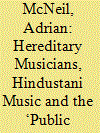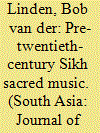| Srl | Item |
| 1 |
ID:
159384


|
|
|
|
|
| Summary/Abstract |
In the late nineteenth century, Hindustani music and its culture arrived in Calcutta's public sphere. It was carried there as much through the migration and agency of the professional lives of the ‘ustads from the North’ as it was through the forces of coloniality, modernity and Hindu nationalism. On its arrival, the performance practice and social organisation of Hindustani music culture came face to face with the bustle of social and cultural experimentation and innovation that came to define the ‘Bengal Renaissance’. Hindustani music was certainly not isolated from this larger cultural dynamic and, over four or five decades, its practitioners were compelled to formulate a series of responses in order to negotiate the challenges which this public sphere posed to past practices of this tradition transplanted from North India to Bengal. Their responses bring into focus a number of significant issues: firstly, the nature of these responses and the consequences they had for the development of Hindustani music and its culture; secondly, the issue of the discourse of ‘modern’ Hindustani music that arose from this encounter; and thirdly, questions over whose voice(s) were represented and whose voice(s) were marginalised in the process. Finally, there is the issue of how these responses still resonate in Hindustani music practice today, as they continue to reside in and frame the contemporary musical imagination.
|
|
|
|
|
|
|
|
|
|
|
|
|
|
|
|
| 2 |
ID:
139460


|
|
|
|
|
| Summary/Abstract |
This article discusses the canonisation and institutionalisation of Sikh sacred music (kirtan) at the courts of the ten Sikh gurus and the later Sikh maharajas in Lahore and Patiala. At the same time, it emphasises possible parallels with what happened musically at the Mughal court. Essentially, the article argues that pre-twentieth-century Sikh sacred music was Hindustani (classical) music because of its performance practice, instruments used, music theory and the interactions between Sikh court musicians and those of the Mughal and other North Indian courts, as well as of different Hindustani music lineages (gharanas). Ultimately, it underlines the importance of contextual history, for example in terms of Mughal culture, the imperial encounter and globalisation, in forming a firm understanding of continuity and change over five centuries of kirtan performance practice.
|
|
|
|
|
|
|
|
|
|
|
|
|
|
|
|